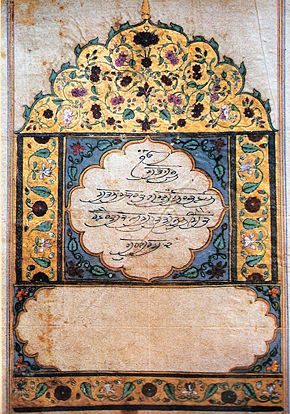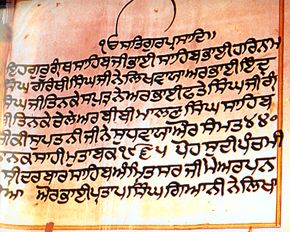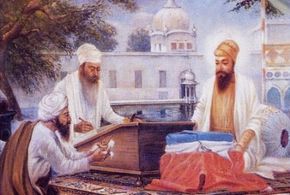Guru Granth Sahib
2008/9 Schools Wikipedia Selection. Related subjects: Religious texts
| This article contains Indic text. Without rendering support, you may see question marks, boxes or other symbols instead of Indic characters; or irregular vowel positioning and a lack of conjuncts. |
 |
|
| Religion | Sikhism |
| Other Names: | Punjabi: ਗੁਰੂ ਗ੍ਰੰਥ ਸਾਹਿਬ Guru Granth Sahib Adi Granth The Head of the Sikh religion The Eternal Guru of the Sikhs |
| Senior posting | |
|---|---|
| Based in | Initially Punjab, India |
| Title | The eleventh Guru of Sikhism |
| Period in office | 7th October, 1708 - Eternal |
| Predecessor | Guru Gobind Singh 10th Guru of the Eleven Gurus of Sikhism |
| Successor | None |
| Religious career | |
| Post | Guru |
| Personal | |
| Date of birth | n/a |
| Place of birth | n/a |
| Date of death | n/a |
| Place of death | n/a |
The Guru Granth Sahib (Punjabi: ਗੁਰੂ ਗ੍ਰੰਥ ਸਾਹਿਬ, gurū granth sāhib or SGGS) is revered as the eternal Guru of Sikhism, the physical form of the living Guru of the Sikhs, and is also their holy book.The term Guru represents the position that the Granth holds in Sikhism, and the term Sahib is used to give respect and show superiority in India . The highest seat of authority in Sikhism rests with the Granth or Guru Granth Sahib. However, the authority of Guru Granth Sahib is restricted to spiritual aspect and not temporal aspect. Any decision, which is likely to affect the Sikhs in any manner whatsoever is taken by Gurmatta, in the presence of Guru Granth Sahib.The term "Gurmatta" signifies the process of decision making among the Sikhs, by which a general meeting is held and presided by Panj Piare(five beloved of the Guru).No single person occupies or possesses the sole authority regarding decision making. The Guru Granth Sahib is given the honorific prefix Sri ( Sri)which denotes its holiness for Sikhs. It is also called Gyan Guru meaning full of knowledge or wisdom.
The Guru Granth Sahib was made guru of Sikhs by the last of the living Gurus ( Guru Gobind Singh) in 1708. While there are no priests in Sikhism, there were masands (local community leaders) of the Guru whose duties were abolished by Gobind Singh as he felt they had become full of ego and corrupt. The only position he left was a Granthi to look after the Guru Granth Sahib; any Sikh is free to become Granthi or read from the Guru Granth Sahib.
Punjabi: "ਸਬ ਸਿੱਖਨ ਕੋ ਹੁਕਮ ਹੈ ਗੁਰੂ ਮਾਨਯੋ ਗ੍ਰੰਥ"
Transliteration: "Sab sikhan kō hukam hai gurū mānyō granth"
English: "All Sikhs are commanded to regard the Granth as their Guru".
The role of Guru Granth Sahib is pivotal in worship in Sikhism. It is the source of prayer or worship, and not the object of worship.
"when the true guru is met with, one meets with the perfect god"
The Guru Granth Sahib also contains hymns of saints from other religions, including Hinduism and Sufi Islam, such as Kabir, Baba Farid, Tulsidas, Ravidas and Namdev. The Sikh Gurus also held the views of past saints of the Bhakti movement in high regard, and considered their teachings sacred, and included them in the Guru Granth Sahib, next to their own. The 15 Bhagats are considered equally holy, revered and sacred by Sikhs as the Gurus.
The Guru Granth Sahib is written in the Gurmukhi script and contains many languages including Braj, Old Punjabi, Khariboli, Sanskrit and Persian.
The Guru Granth Sahib contains over 5000 shabhads or hymns which are poetically constructed and set to classical forms of music ragas. They can be set to predetermined musical talas (rhythmic beats).
Below an excerpt from the 15th Ang (limb) of the Guru Granth Sahib:
- ਨਾਨਕ ਕਾਗਦ ਲਖ ਮਣਾ ਪੜਿ ਪੜਿ ਕੀਚੈ ਭਾਉ ॥
- ਮਸੂ ਤੋਟਿ ਨ ਆਵਈ ਲੇਖਣਿ ਪਉਣੁ ਚਲਾਉ ॥
- ਭੀ ਤੇਰੀ ਕੀਮਤਿ ਨਾ ਪਵੈ ਹਉ ਕੇਵਡੁ ਆਖਾ ਨਾਉ ॥੪॥੨॥
- ਮਸੂ ਤੋਟਿ ਨ ਆਵਈ ਲੇਖਣਿ ਪਉਣੁ ਚਲਾਉ ॥
- nānak kāgad lakh manā pari pari kīcai bhā'u
- masū tōti na āva'ī lēkhani pa'unu calā'u
- bhī tērī kīmati nā pavai ha'u kēvadu ākhā nā'u ||4||2||
- masū tōti na āva'ī lēkhani pa'unu calā'u
- O Nanak, if I had hundreds of thousands of stacks of paper, and if I were to read and recite and embrace love for the Lord,
- and if ink were never to fail me, and if my pen were able to move like the wind
- -even so, I could not estimate Your Value. How can I describe the Greatness of Your Name? ||4||2||
- and if ink were never to fail me, and if my pen were able to move like the wind
History
When Guru Angad became the second Guru of Sikhs, Guru Nanak gave him his collection of hymns and teachings in the form of "pothi" or small volume. Guru Angad made additions to it and subsequently handed it to the third Guru. The fourth Guru also composed hymns and preserved them in a pothi.
The fifth Guru, Arjan Dev, with the intention of preserving the hymns of the preceding Gurus, decided to compose a single volume containing them. He also added hymns he had composed and those of some fifteen bhakats or saints of the Bhakti Movement, such as Kabir, Ravidas, Trilochan, Farid and Namdev. Although he added the hymns of other saints, only those hymns which were similar to the teachings of Sikh Gurus or whose message was similar to them were added. He rejected many hymns which were not similar to the teachings of the Gurus or were opposed in their message. The compositions of the bhagats or saints make up about ten per cent of the Granth.
The Adi Granth was completed in 1604. It was installed in Harmandir Sahib (the temple of God), popularly known as the Golden Temple, on September 01, 1604. It was written down on paper by a disciple of Guru Arjan known as Bhai Gurdas, under the direct supervision of the fifth Guru. The original volume of this Granth is still in Kartarpur and bears the signature of the Fifth Guru.
The master copy was initially with Guru Hargobind, but was stolen by one of his grandsons, Dhir Mal, who wanted to lay claim to the title of Guru of Sikhs. The Sikhs, about thirty years later, recovered it forcibly and were made to return it on the order of the ninth Guru, Tegh Bahadur.
Every year on the occasion of Vaisakhi the original Adi Granth is displayed by the descendants of Dhir Mal in Kartarpur. However it does not enjoy the title of Guru of Sikhs, as it is different from the final volume prepared by Guru Gobind Singh at Dam Dama Sahib in 1705, and which was subsequently installed as the final Guru. For instance, it does not contain the hymns composed by the ninth Guru, Tegh Bahadur.
The final composition of Guru Granth Sahib was prepared by Guru Gobind Singh with the scribe Bhai Mani Singh. This final version does not contain any hymns of the sixth, seventh, or eighth Gurus, as they did not compose any. Guru Gobind Singh added the hymns composed by Guru Tegh Bahadur but excluded his own. While at Nanded, Guru Gobind Singh Installed the final version prepared by him as the perpetual Guru of Sikhs on October 20, 1708.
The Guru Granth Sahib is divided into ragas or classical musical notes. The chronological division is on the basis of ragas and not on the order of succession of Gurus. The Sikhs do not lay emphasis on any particular volume of Guru Granth Sahib as a Guru.
Structure
The Guru Granth Sahib is divided into 1430 Angs (limbs), the shabads (hymns) are arranged in 31 ragas, the traditional Indian musical measures and scales. Within the ragas, they are arranged by order of the Sikh Gurus, with the shabads of the various saints following. The shabads are written in various meters and rhythms, and are organized accordingly. For instance, Ashtapadi - eight steps, or Panch-padi - five steps.
The Adi Granth starts with the a non-raga section with Japji as the first entry. This is followed by thirty-one ragas in the following serial order: Raga Sri, Manjh, Gauri, Asa, Gujri, Devagandhari, Bihagara, Wadahans, Sorath, Dhanasri, Jaitsri, Todi, Bairari, Tilang, Suhi, Bilaval, Gond (Gaund), Ramkali, Nut-Narayan, Mali-Gaura, Maru, Tukhari, Kedara, Bhairav (Bhairo), Basant, Sarang, Malar, Kanra, Kalyan, Prabhati and Jaijawanti. Then come saloks, swayas and the scriptures that could not be indexed in the other raga categories (such as salok vaaraan te vadheek.) The final sections are Mundavani, a salok and Raag Maala.
English translation
In the West, it has become common to use the English translation of the Sri Guru Granth Sahib in Gurdwara programs and Akhand Paaths, because many of the western Sikhs are not fluent in Gurmukhi. This has served to bring many to the presence of the Guru who otherwise may not have had the opportunity to experience the "Shabad Guru" (literally "Word Guru"). However, only a Granth Sahib that is in in Gurmukhi script is considered to be the Guru. The English translation may also be installed on a separate Palki (throne) on the side and serve to better illuminate the sangat in the meaning of the words of the Guru. The English translation may be used during an Akhand Paath in which the participants are not fluent in Gurmukhi. However, if a special gurdwara program is being planned, the English Akhand Paath days can be accommodated so that the full Gurmukhi Bir of Guru Granth Sahib presides.
A Sikh is encouraged to learn Gurmukhi so as to deepen his or her experience of Gurbani and so that the full body of the Guru may be installed in the gurdwara. Ideally, English and other translations of the Guru Granth Sahib should be considered as just another "style" of talking or praising the guru. While some Sikhs believe that it is necessary to learn Punjabi/Gurmuki to understand and appreciate the Sikh texts, many do not hold this view.
Printing
The first printed copy of Guru Granth Sahib was made in 1864. Since the early 20th century Guru Granth Sahib has a standard 1430 limbs; thus a text can be easily referred to by page number.
The printing is done in an authorized printing press in the basement of the Gurdwara Ramsar in Amritsar.
Treatment of damaged copies
Any copies of the Guru Granth Sahib which are too badly damaged to be used, and any printer's waste which has any of its text on, are cremated with a similar ceremony as cremating a deceased person. Examples of the care of damaged Granth Sahibs include:
- : A copy damaged in a fire
- A copy damaged in a fire
- : 4 copies damaged in New Orleans by the flood caused by Hurricane Katrina
- : on the Nicobar Islands after the 2004 tsunami (end of page).
- MrSikhNet.com Blog query about an accumulation of download printouts of Sikh sacred text
Comments On Sri Guru Granth Sahib By Non Sikhs
This is what Max Arthur Macauliffe writes about the authenticity of the Guru's teaching.
The Sikh religion differs as regards the authenticity of its dogmas from most other theological systems. Many of the great teachers the world has known, have not left a line of their own composition and we only know what they taught through tradition or second-hand information. If Pythagoras wrote of his tenets, his writings have not descended to us. We know the teachings of Socrates only through the writings of Plato and Xenophon. Buddha has left no written memorial of his teaching. Kungfu-tze, known to Europeans as Confucius, left no documents in which he detailed the principles of his moral and social system. The founder of Christianity did not reduce his doctrines to writing and for them we are obliged to trust to the gospels according to Matthew, Mark, Luke and John. The Arabian Prophet did not himself reduce to writing the chapters of the Quran. They were written or compiled by his adherents and followers. But the compositions of Sikh Gurus are preserved and we know at first hand what they taught.
Miss Pearl S. Buck, a Nobel laureate, gives the following comment on receiving the First English translation of the Guru Granth Sahib:
.... I have studied the scriptures of the great religions, but I do not find elsewhere the same power of appeal to the heart and mind as I find here in these volumes. They are compact in spite of their length, and are a revelation of the vast reach of the human heart, varying from the most noble concept of God, to the recognition and indeed the insistence upon the practical needs of the human body. There is something strangely modern about these scriptures and this puzzles me until I learned that they are in fact comparatively modern, compiled as late as the 16th century, when explorers were beginning to discover that the globe upon which we all live is a single entity divided only by arbitrary lines of our own making. Perhaps this sense of unity is the source of power I find in these volumes. They speak to a person of any religion or of none. They speak for the human heart and the searching mind.
From the foreword to the English translation of the Guru Granth Sahib by Gopal Singh, 1960)(bold added later)
Message of Guru Granth Sahib
The Guru Granth Sahib is intended to lead the entire human race out of the dark age of Kali Yuga to a life in peace, tranquility and spiritual enlightenment. The main message can be summarized as:
- Meditate on the name of the Infinite Creator (God)
- God is the universal Creator of all
- All peoples of the world are equal
- Women as equal
- Speak and live truthfully
- Control the five vices
- Live in God's Hukam (universal laws)
- Practice humility, kindness, Compassion, love, etc
Care and protocol
The Guru Granth Sahib is the eternal Guru of Sikhs and is treated as such by them. It is mainly looked after by the granthi, who fans it during the day and takes it to its bedroom during the night. Sikhs bow before the Guru Granth Sahib and show utmost respect to it. While in the presence of their Guru they seat it on a place higher than where they sit. The Fifth Guru used to sleep in the presence of the Adi Granth to show it reverence.
Personal behaviour
The following care is taken by Sikhs or any person who is in the presence of Guru Granth Sahib in a gurudwara:
- The visitors to a gurudwara keep their heads covered all times and remain barefoot inside the room where Guru Granth Sahib is seated.
- Basic standards of hygiene are observed and the person must ensure that he has bathed, especially if he or she is to recite hymns while reading from it.
- A person must not make small talk or create noise in Guru's presence. He or she should be respectful to the Guru and others.
Environment
The Granth Sahib is placed in a room which is free from foreign elements
. It is covered in a cloth, which is changed daily, and placed on seat higher than normal seating. A canopy is always placed above it, usually hanging from the ceiling. A chaur sahib, used to fan the Guru, is provided beside it with a small platform to house the Karah Parshad or holy offering and other implements.
Transporting
Five initiated Sikhs are to accompany the Guru at all times when traveling, with one Sikh to do Chaur Sahib Seva. The Sikh carrying the Guru must put a clean cloth ( rumalla) on his or her head before carefully and with respect placing the Guru on this rumalla. At all times the Guru should be covered with a small rumalla so that the Guru's body ( saroop) is always fully covered. There should be recitation of Waheguru at all times. A kamarkassa (waist band) is be tied around Sri Guru Granth Sahib.
The Eleven Gurus of Sikhism
| # | Name | Date of birth | Guruship on | Date of ascension | Age |
|---|---|---|---|---|---|
| 1 | Nanak Dev | 15 April 1469 | 20 August 1507 | 22 September 1539 | 69 |
| 2 | Angad Dev | 31 March 1504 | 7 September 1539 | 29 March 1552 | 48 |
| 3 | Amar Das | 5 May 1479 | 26 March 1552 | 1 September 1574 | 95 |
| 4 | Ram Das | 24 September 1534 | 1 September 1574 | 1 September 1581 | 46 |
| 5 | Arjan Dev | 15 April 1563 | 1 September 1581 | 30 May 1606 | 43 |
| 6 | Har Gobind | 19 June 1595 | 25 May 1606 | 28 February 1644 | 48 |
| 7 | Har Rai | 16 January 1630 | 3 March 1644 | 6 October 1661 | 31 |
| 8 | Har Krishan | 7 July 1656 | 6 October 1661 | 30 March 1664 | 7 |
| 9 | Tegh Bahadur | 1 April 1621 | 20 March 1665 | 11 November 1675 | 54 |
| 10 | Gobind Singh | 22 December 1666 | 11 November 1675 | 7 October 1708 | 41 |
| 11 | Guru Granth Sahib | n/a | 7 October 1708 | Eternity | n/a |


